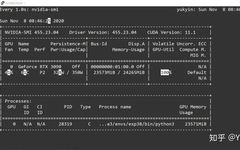For academic sharing only, does not represent the stance of this public account. Contact for removal if infringing.Reprinted from:Author丨Yukyin@ZhihuSource丨https://zhuanlan.zhihu.com/p/279401802Editor丨Extreme City Platform
I recently got a 3090 and found that the various environment configurations written online are quite chaotic and slow. So I tested the fastest 3090 configuration environment myself, feel free to add more!
Basic environment (the entire process takes about 5 minutes or even less)
py37 or py38 cuda11.0 cudnn8.0.4 tf2.5 (tf-nightly) or tf1.15.4 pytorch1.7 keras2.3(1) Download from the official website and install the graphics driver:
bash NVIDIA-Linux-x86_64-455.23.04.run(2) Install Anaconda and change the source
bash Anaconda3-5.2.0-Linux-x86_64.sh vim ~/.bashrc export PATH=/home/XXX/anaconda3/bin:$PATH (XXX is your username) (add this line at the end of the file) source ~/.bashrc conda config --add channels https://mirrors.tuna.tsinghua.edu.cn/anaconda/pkgs/main/ conda config --add channels https://mirrors.tuna.tsinghua.edu.cn/anaconda/pkgs/free/ conda config --add channels https://mirrors.tuna.tsinghua.edu.cn/anaconda/cloud/conda-forge conda config --add channels https://mirrors.tuna.tsinghua.edu.cn/anaconda/cloud/msys2/ conda config --add channels https://mirrors.tuna.tsinghua.edu.cn/anaconda/cloud/pytorch/ conda config --set show_channel_urls yes then vim ~/.condarc, delete defaults(3) Create a virtual environment, usually use py37 or py38 (the following operations are all done in the virtual environment)
conda create -n exp38 python==3.8 conda activate exp38(4) Install cuda11.0 and pytorch1.7 (no need to conda install cudatoolkit==11.0)
conda install pytorch torchvision cudatoolkit=11(5) Install cudnn8 (because conda does not support downloading cudnn in cudatoolkit=11)
Download cudnn from https://developer.nvidia.com/rdp/cudnn-download, unzip it and go to the cuda/lib64 path, copy all files into the corresponding virtual environment (exp38) lib.
(6) Install tf2.5 (do not install tensorflow-gpu==2.4.0rc0, it will report an error ‘NoneType’ object has no attribute ‘TFE_MonitoringDeleteBuckets’)
pip install tf-nightly-gpu -i http://pypi.douban.com/simple --trusted-host pypi.douban.com pip install tf-nightly -i http://pypi.douban.com/simple --trusted-host pypi.douban.com(7) Install tf1.15.4
This refers to the installation steps of tf1.15.4 by this expert: https://blog.csdn.net/wu496963386/article/details/109583045?utm_medium=distribute.wap_relevant.none-task-blog-BlogCommendFromMachineLearnPai2-2.wap_blog_relevant_pic
pip install google_pasta-0.2.0-py3-none-any.whl nvidia_cublas-11.2.1.74-cp36-cp36m-linux_x86_64.whl nvidia_cuda_cupti-11.1.69-cp36-cp36m-linux_x86_64.whl nvidia_cuda_nvcc-11.1.74-cp36-cp36m-linux_x86_64.whl nvidia_cuda_nvrtc-11.1.74-cp36-cp36m-linux_x86_64.whl nvidia_cuda_runtime-11.1.74-cp36-cp36m-linux_x86_64.whl nvidia_cudnn-8.0.4.30-cp36-cp36m-linux_x86_64.whl nvidia_cufft-10.3.0.74-cp36-cp36m-linux_x86_64.whl nvidia_curand-10.2.2.74-cp36-cp36m-linux_x86_64.whl nvidia_cusolver-11.0.0.74-cp36-cp36m-linux_x86_64.whl nvidia_cusparse-11.2.0.275-cp36-cp36m-linux_x86_64.whl nvidia_dali_cuda110-0.26.0-1608709-py3-none-manylinux2014_x86_64.whl nvidia_dali_nvtf_plugin-0.26.0+nv20.10-cp36-cp36m-linux_x86_64.whl nvidia_nccl-2.7.8-cp36-cp36m-linux_x86_64.whl nvidia_tensorrt-7.2.1.4-cp36-none-linux_x86_64.whl tensorflow_estimator-1.15.1-py2.py3-none-any.whl nvidia_tensorboard-1.15.0+nv20.10-py3-none-any.whl nvidia_tensorflow-1.15.4+nv20.10-cp36-cp36m-linux_x86_64.whl -i http://pypi.douban.com/simple --trusted-host pypi.douban.com(8) Install keras2.3
pip install keras==2.3 -i http://pypi.douban.com/simple --trusted-host pypi.douban.com(9) Testing (you can also test using cuda10.2, but it seems you cannot write data to the gpu)

pytorch
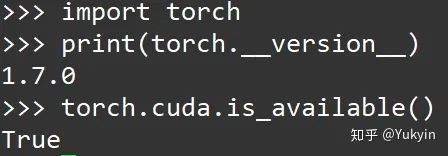
tensorflow-2.5 or 1.15.4
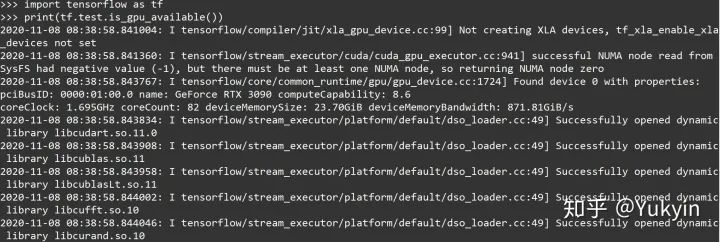
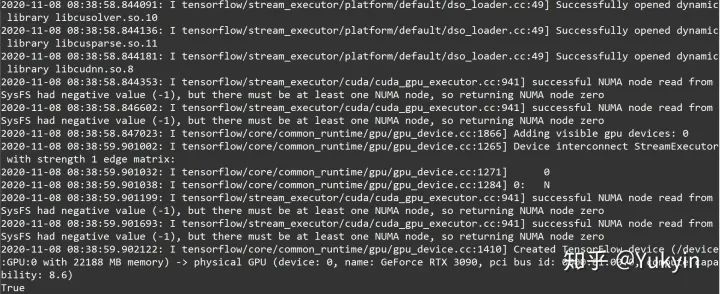
keras (testing requires modifying some source code _get_available_gpus())
import tensorflow as tf import keras.backend.tensorflow_backend as tfback print("tf.__version__ is", tf.__version__) print("tf.keras.__version__ is:", tf.keras.__version__) def _get_available_gpus(): if tfback._LOCAL_DEVICES is None: devices = tf.config.list_logical_devices() tfback._LOCAL_DEVICES = [x.name for x in devices] return [x for x in tfback._LOCAL_DEVICES if 'device:gpu' in x.lower()] tfback._get_available_gpus = _get_available_gpus from keras import backend as KK tensorflow_backend._get_available_gpus()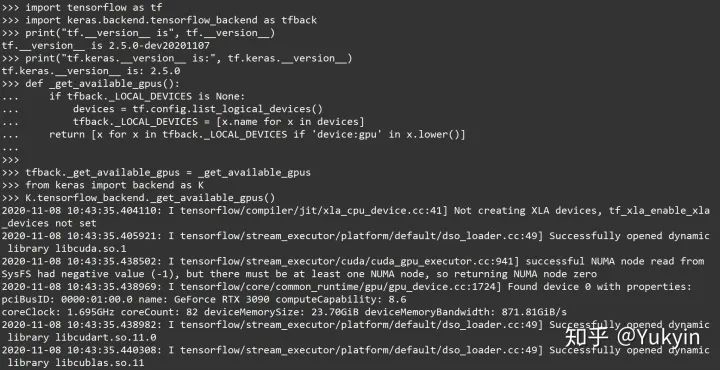
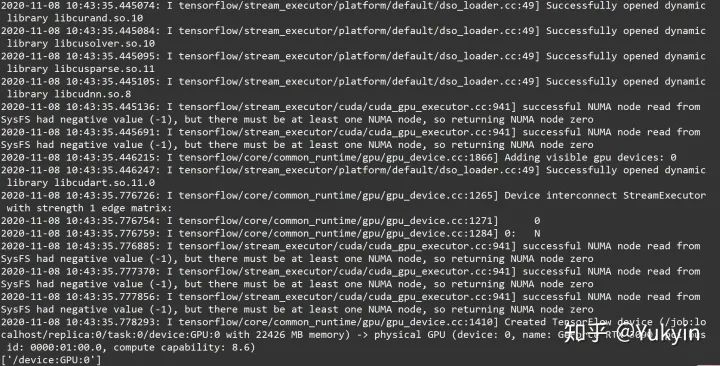
Postscript: The actual 3090 requires cuda11.1, but pytorch and tf currently only support 11.0. And honestly, there is no need to install cuda and cudnn separately, just do it in the virtual environment.
Updated on 20210102: Tested tf1.15.4, it is usable, data can be written to the gpu. The article has been updated.

